Khajuraho is one of the UNESCO World Heritage Sites in India with some of the finest temple sculptures in Madhya Pradesh in India. Today, only 20 of the original 85 temples have survived the ravages of time. Commonly misconstrued to depict only erotic sculptures, my firsthand experience does not say so. The fine carvings depict poignantly the daily lives in the 11th century. Mithuna Shilpa occupies less than 10% of the Khajuraho temple sculptures.
History of Khajuraho Temple Sculptures
Khajuraho was the religious capital of Chandela rulers. They built 85 temples from 950 to 1050 AD and dedicated them to Shiva, Vishnu, and Jain Tirthankara. Kharjuravahaka or ancient Khajuraho comes from date palm meaning khajur and vahaka meaning bearer. 2 golden date-palm trees adorned the temple gates , therefore the name.
The Hindu kings Yashovarman and Dhanga built most of the temples mostly of hard river sandstone visible in shades of buff, pink and pale yellow. Khajuraho retained religious significance till about the 14th century. As time passed , dense foliage covered the temples. In 1838, a British army captain, TS Burt, from the Asiatic Society rediscovered this temple complex.
Our guide did narrate an interesting legend of Khajuraho. The moon god , Chandra was the ancestor of the Chandela dynasty. He seduced Hemwati, the beautiful young daughter of a Brahmin priest on a full moon night. She gave birth to Chandra Varman, founder of the Chandela dynasty. Once he became a powerful ruler, his mother appeared to him in a dream and told him to build temples depicting human passions and the futility of desires. Thus, the Chandela dynasty built Khajuraho through a century.
What to see?
You can view the flawless Khajuraho Temple Sculptures in the 4 temple complexes :
- Western Group of Temples
- Jain Group of Temples
- South Eastern Group of Temples
- Eastern Group of Temples
The temples showcase exquisite craftsmanship depicting meditation, spiritualism, royalty, battles and some erotic art (Mithuna Shilpa). The elements have considerably weathered several sculptures. Today , the Archaeological Survey of India is actively restoring and reconstructing these Khajuraho Temple Sculptures.
WESTERN GROUP OF TEMPLES
The Western Group is the most significant group in Khajuraho Temple Sculptures. It is said to be the cosmic hexagon of the 3 forms of Shiva.
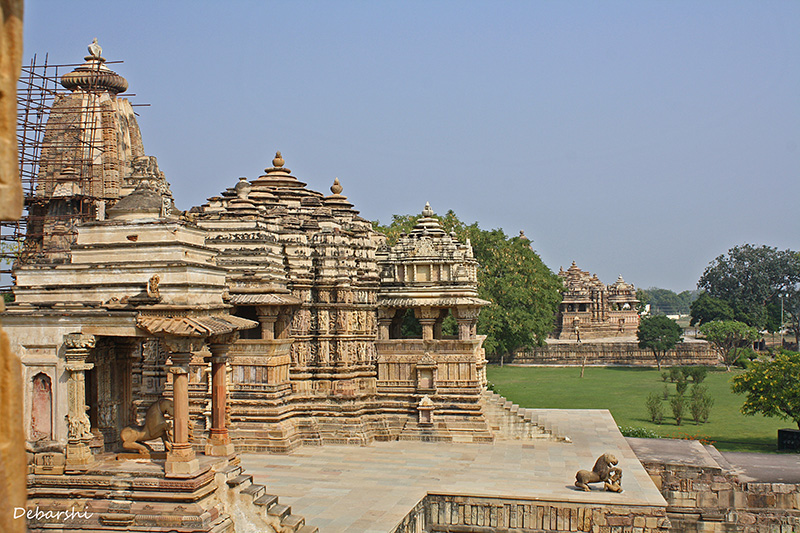
KANDARIYA MAHADEO TEMPLE
This is the largest (31 meters in height and 20 meters in width) temple in Khajuraho meaning “Great God of the Cave”. This temple reveres Lord Shiva. The temple shares the huge plinth 4 meters high with the Mahadev shrine and Devi Jagdambi Temple. Especially relevant in the temple design – the transition from the night of ignorance to the eternal day of wisdom depicts spiritual progress in humans.
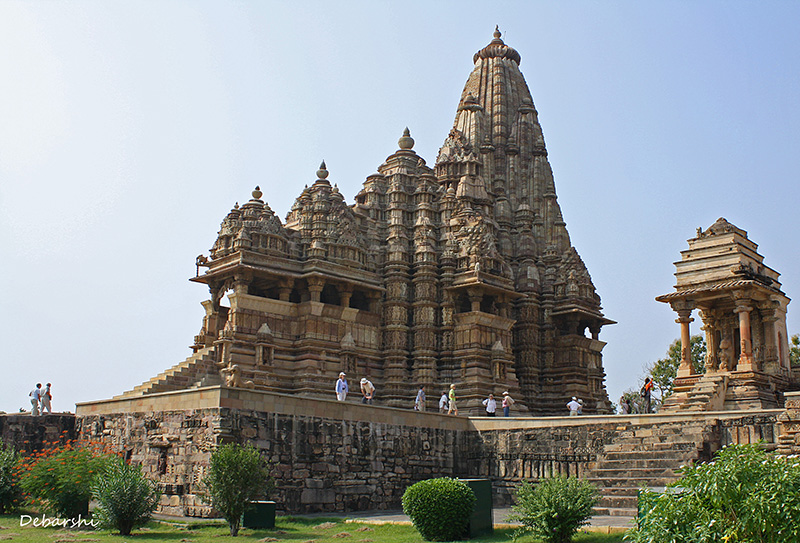
The main temple is in the shape of a steep mountain. This symbolises the abode of Lord Shiva – Meru or Kailash. The pyramidal porch, 84 miniature spires rise culminating in the conical shikhar (35.3 meters from the ground) maintains this impression. Approximately 870 stone Khajuraho Temple Sculptures adorn the Kandariya Mahadeo temple. It is said to be in a double cross layout.
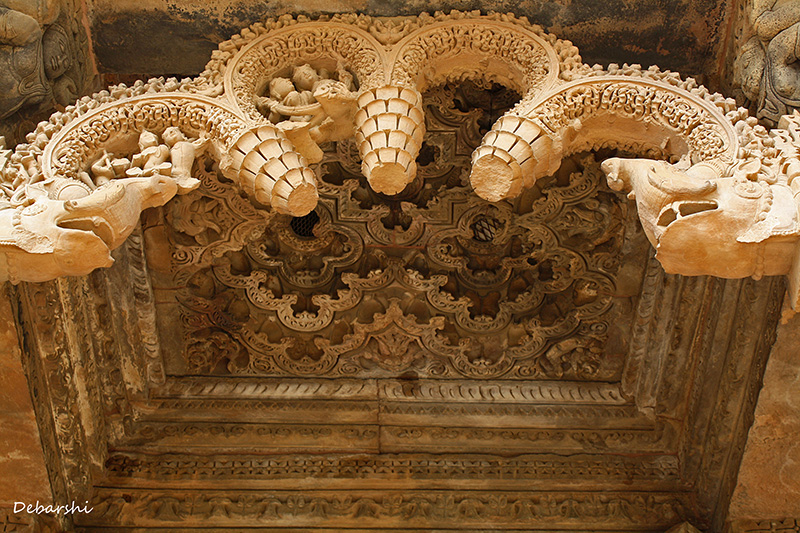
A KirtiMukha is the first work of art at the entrance . An exquisite and intricately carved monolithic torana (garland entrance) greets you. This torana draws out from the mouths of celestial nymphs and makaras (mythical crocodiles).
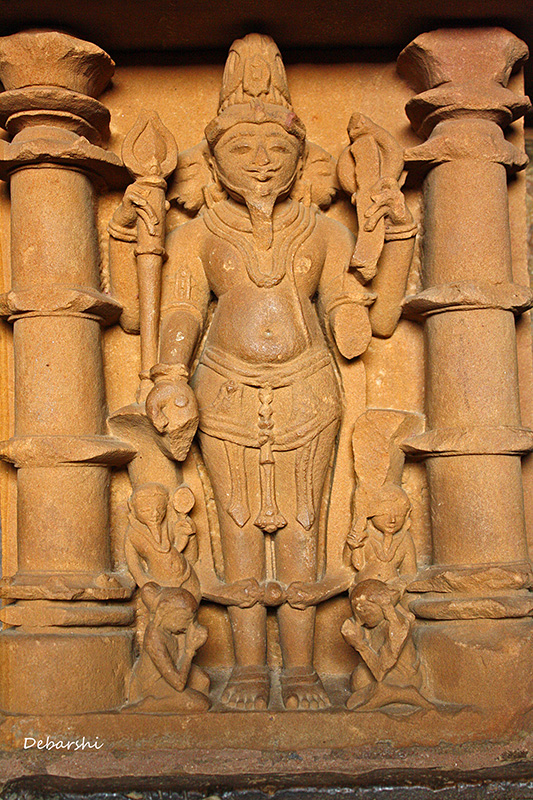
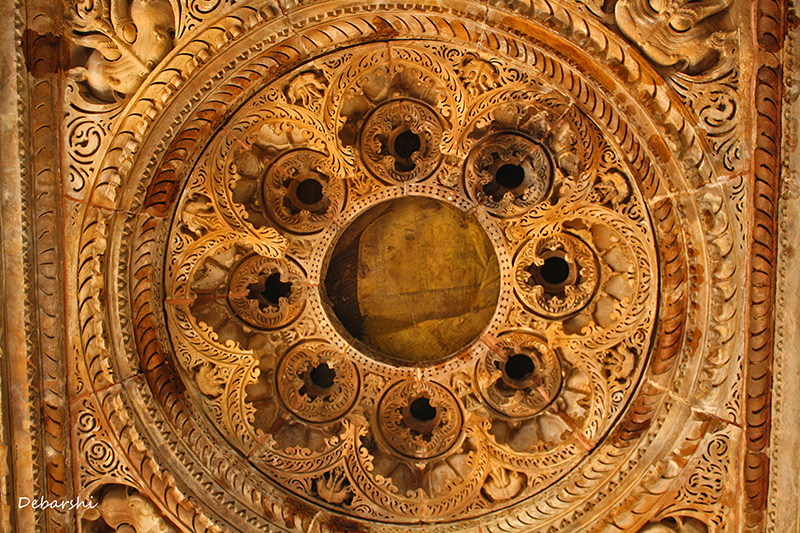
On entering the temple, comes the three halls or mandapas sequentially rising in height and width leading to the poorly illuminated cave like sanctum or GarbaGriha housing the Shiva Linga (the phallic emblem of Shiva).
Temple Walls
The external wall Khajuraho temple sculptures are in 3 panels adorned with Shiva as a bridegroom, women engaged in activities like gazing into the mirror, applying Kohl to eyes. Of course, there are the famed Mithuna Shilpa panels like kissing couples or love making in complex, tantric, acrobatic postures,but restricted only to the outer northern and southern walls.
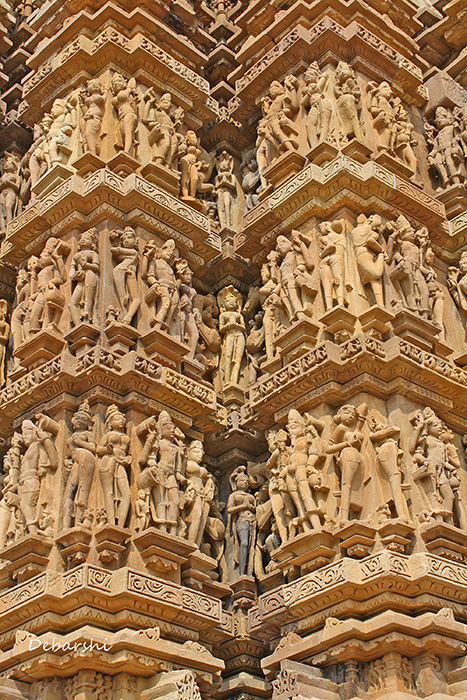
As you move along the outer wall of the temple (always clockwise with your right side along the temple wall), you will see panels depicting scenes from court life. The nine alcoves around the temple show the SaptaMatrikas (7 mother goddesses) – Brahmi seated on a swan; Maheshwari with three eyes seated on Nandi , Kumari , Vaishnavi mounted on Garuda, the boar-headed Varahi; the lion-headed Narasimhi and demon slaying Chamunda along with Ganesha , Virabhadra.
The inner temple walls are sculpted with Apsaras,(nymphs) and other celestial beings engaged in protection against evil and serpent queens. There is an interesting play of sunlight creating a shadow light effect. The Holy Trinity Tridev – Shiva with a trident and snake, Vishnu on the left and Brahma to the right adorns the main lintel.
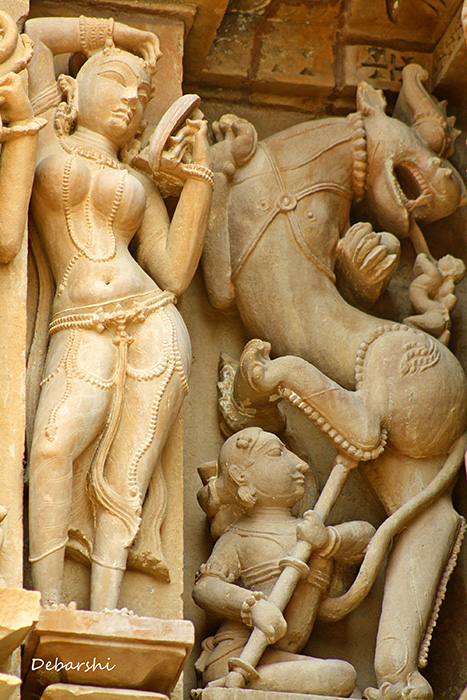
LAKSHMANA TEMPLE
The Lakshmana temple is a Sandhara temple. The temple venerates Lord Vishnu. It is probably the earliest (954 AD) temple built by Yashovarman. The Lakshmana temple is almost 26 meters in length and has 4 subsidiary shrines in the corners of the rectangular plinth. There are almost 230 sculpture panels each a meter high. Panchayatana is the predominant style of the temple.
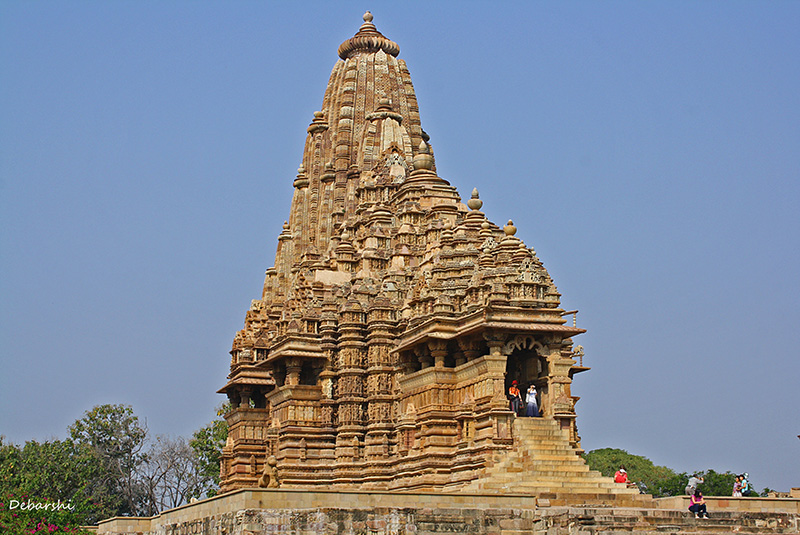
The sanctum is planned like a PanchRatha . A cluster of small spires form the main Shikhar. Amazing sculptures of royal processions, battles and court scenes embellish the raised base (Adhishthana). Do observe the balconied windows and ornate balustrades.The outer temple wall has detailed sculpture panels of musicians, dancers, hunting scenes, soldier processions with horses and rows of elephants as if bearing the weight of the universe.
The hunting scenes are quite elaborate. For example : A fawn mourning its wounded doe and the repentant hunter kneeling. You will also see superb sculptures of women in traditional costume and jewellery engaged in mundane activities like applying Kohl, gazing into a mirror, scrubbing their arched backs or watering a holy plant. There are some Mithuna Shilpa in the north & south side. For example: Shiva in a passionate embrace with his wife Parvati.
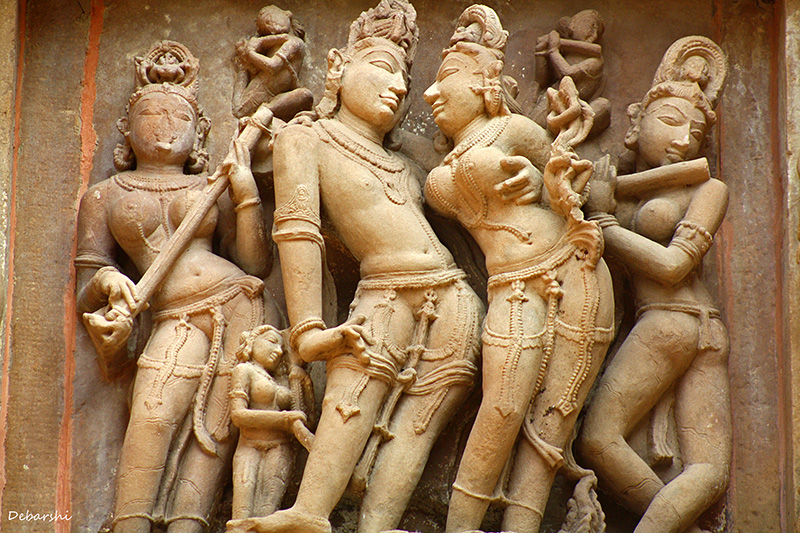
The entrance to this temple is also in the east and with an ornate Makara Torana. You will see carvings of Vishnu avatars in the interior walls. The central beam has the goddess Lakshmi flanked by Brahma and Vishnu. The inner sanctum or GarbaGriha houses Vishnu in the Vaikunth avatar. The Vaikunth avatar of Vishnu has 4 arms and 3 heads – human, wild boar and lion.
DEVI JAGADAMBI TEMPLE
Much smaller in scale and on the same platform as the Kandariya Mahadeo, this temple deifies the mother goddess.
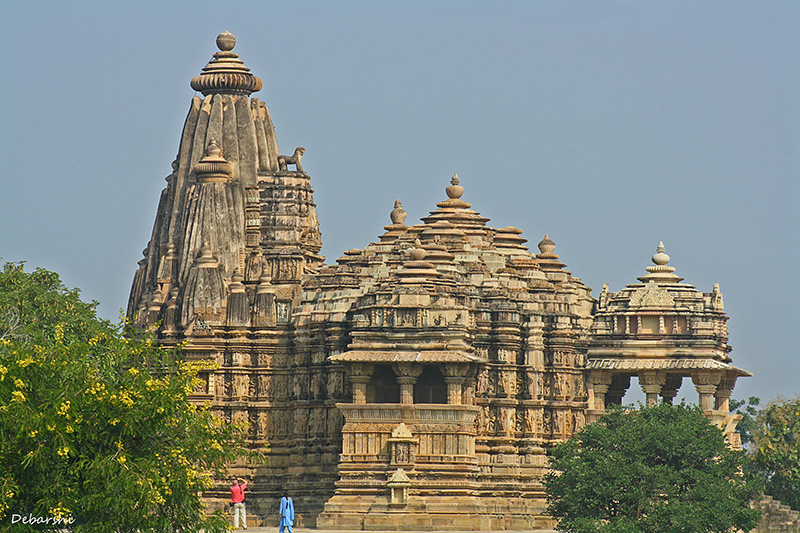
The temple is in three parts – an entrance portico (Ardha Mandapa) leading to the Maha Mandapa and then to the inner sanctum (GarbaGriha). The sculptures are in small recesses in north, south and west. Noteworthy are the sculptures of Brahma, Vishnu & Shiva with their paramours. Remember to also view the sculpture of Varaha in a half human & boar incarnation carrying the earth goddess Bhudevi.
The GarbaGriha is the most famous attribute in this temple. The goddess of the Universe, Jagdambi is the main deity. The central lintel has a four armed standing Vishnu figure. The massive altar with heavily adorned walls and the carvings in the temple panels back the fact that this was a Vishnu temple.
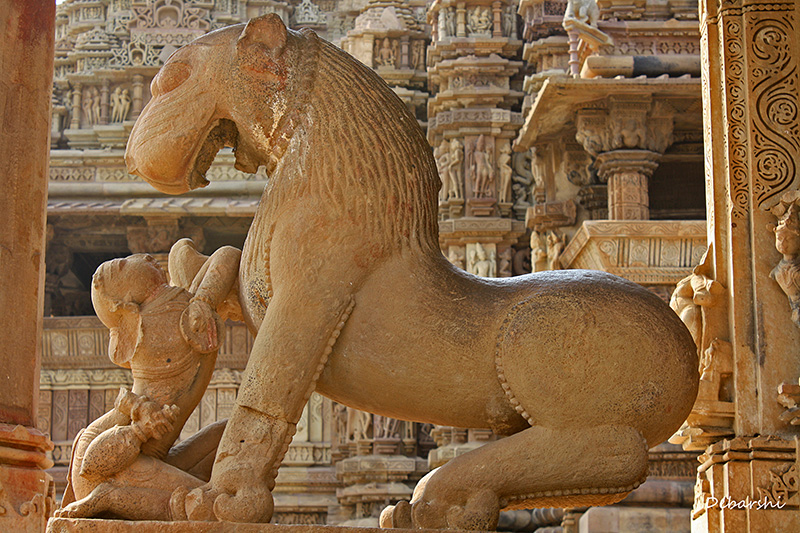
There is a common myth that Lord Vishnu was the deity in this temple. It was later committed to Goddess Parvati and then painted black to appear as Goddess Kali.
MATANGESHWAR TEMPLE
The Matangeshwar Temple is a Shiva (Mrityunjaya Mahadeo) temple. This was built in the early 10th century by Chandra Deva. Even today , Hindu devotees throng this temple .Unlike the other temples, there are no sculptures adorning the external and internal walls except the ceiling. Some of the largest Shiva lingams were in this temple (about a meter in diameter and more than 2.5 meter high). Noteworthy is the open air Khajuraho temple image gallery to the south with some of the most wonderful sculptures and friezes found here.
CHITRAGUPTA TEMPLE
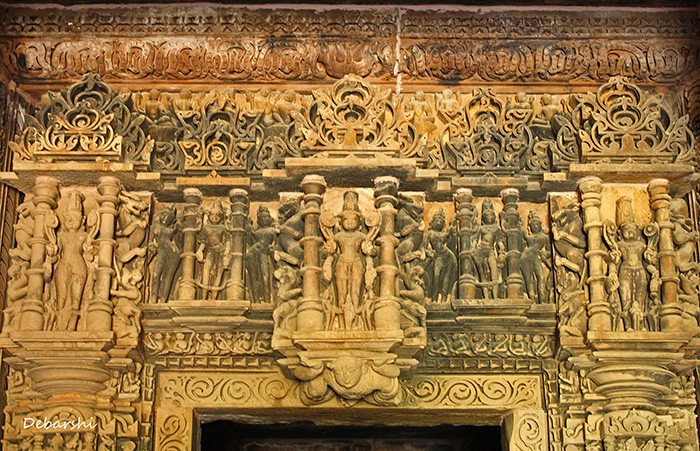
Built in 11th century temple, the Chitragupta temple venerates Vishnu and Surya, the Sun God.
Scenes from palace lives, hunting processions, Apsaras, Mithuna Shilpa, Vyalas, Surasundaris and ascetic figures adorn the external facades . A spectacular carving of 11-headed Vishnu in the supreme form and his 10 ten incarnations adorn the south facade.
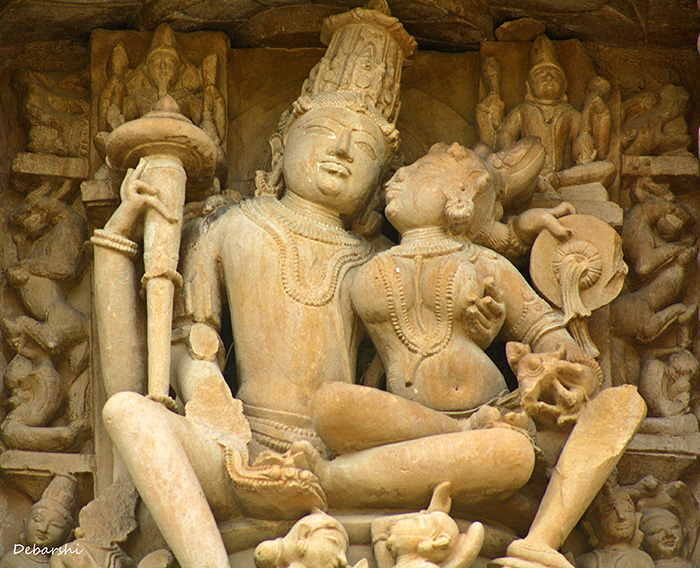
The entrance has 3 small figures of Lord Surya leading to the GarbaGriha. Especially striking is the octagonal ceiling of the MahaMandapa. The enormous 2 meter tall statue of Surya riding a chariot reined in by seven horses (don’t be disappointed because it is slightly broken) will leave you awestruck.
As you step outside, you will also see the Chopra, a three-storied stepped tank.
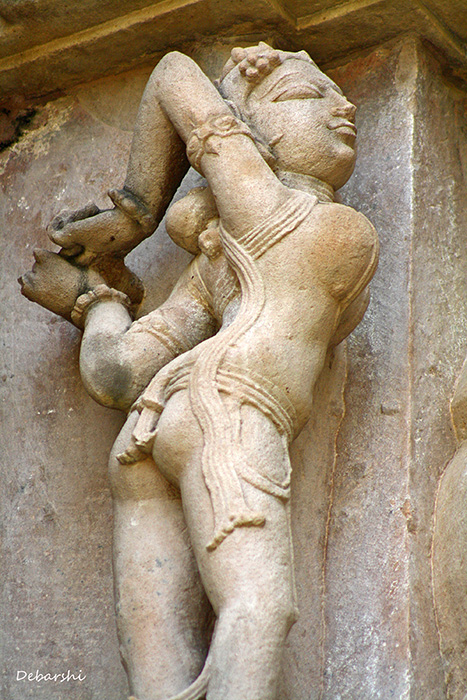
VISHVANATHA TEMPLE
Probably built between 999 AD – 1002 AD, this temple deifies Shiva, also known as Lord of the Universe – Vishvanatha.
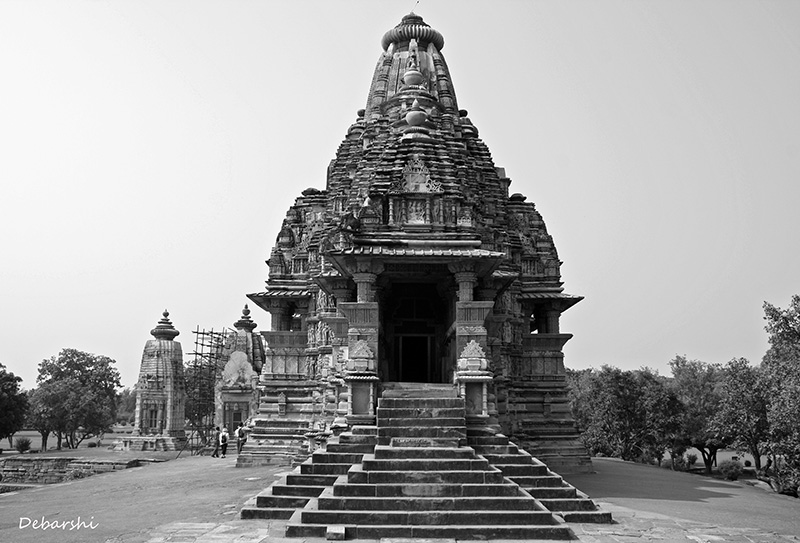
The architecture of this temple is quite akin to the Lakshmana and Kandariya Mahadeo temples in the panchayatana style. The main shrine faces the east and only two of the four smaller shrines are surviving today.The gorgeous sculptures of SaptaMatrikas, Parvati , a dancing Ganesha adorn the temple base. There are other celestial creatures and lions and elephants on each side. The northern & southern walls are carved with Mithuna Shilpa with some even featuring men in bestiality.
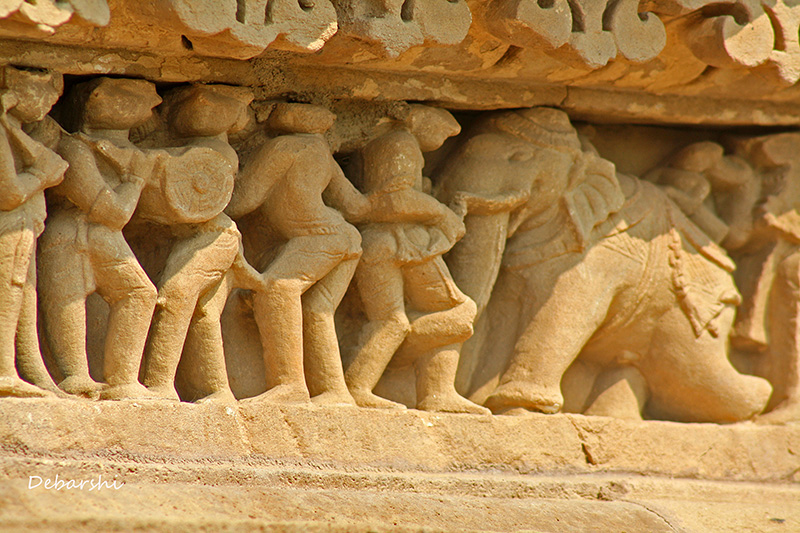
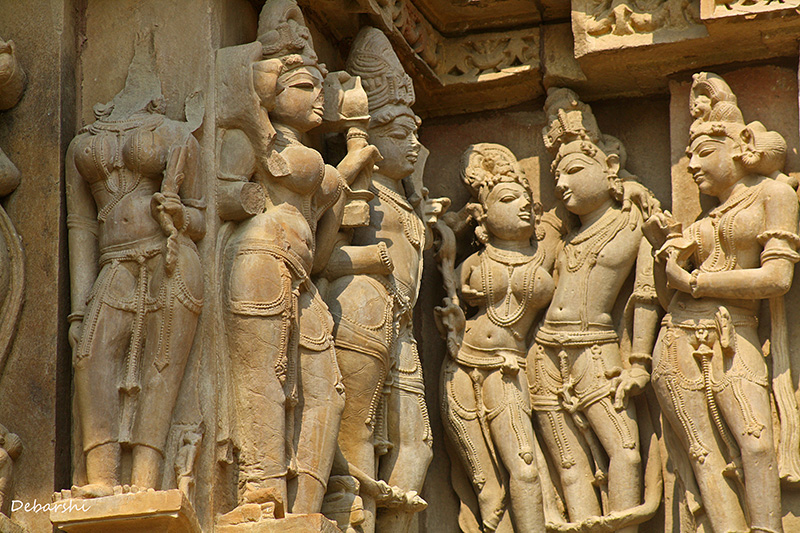
Our guide shows us the most important inscription on the foundation which states that there were two Shiva Lingas one of stone and the other of emerald (Marakatesara). It also says that entrance torana was designed by Vishvakarma (the architect of the gods).
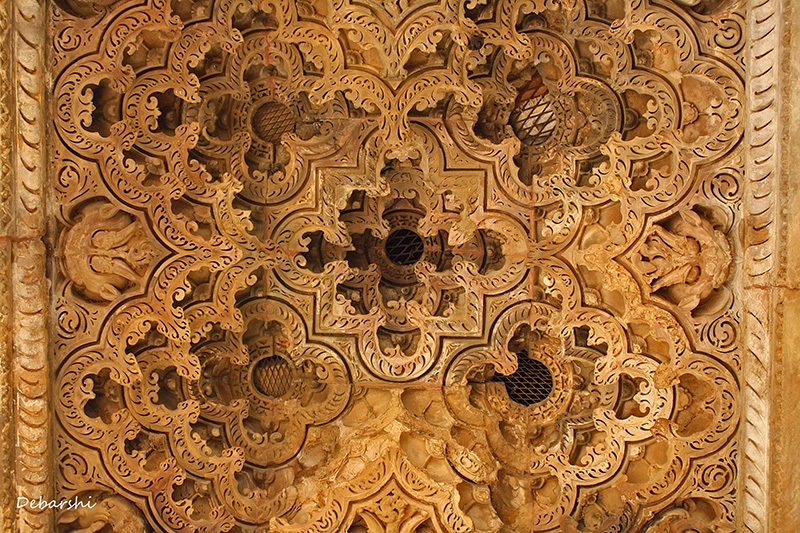
There is open rotunda with a monolithic Nandi Sculpture.
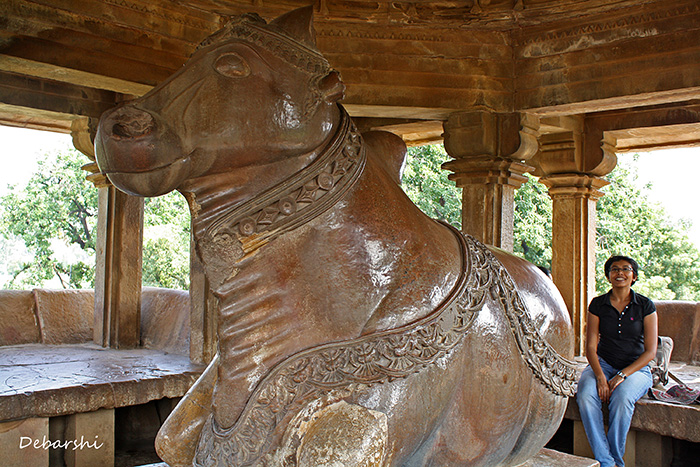
The women are involved in commonplace activities but the beautiful postures and emotions are accentuated .
For example: A celestial beauty playing a flute in an arched pose; A dancing beauty; A mother with her infant on her hip; A damsel colouring her feet.
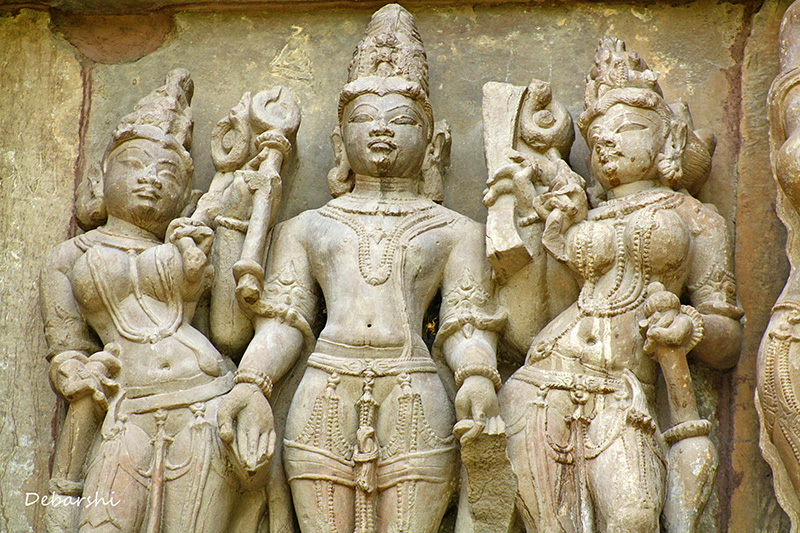
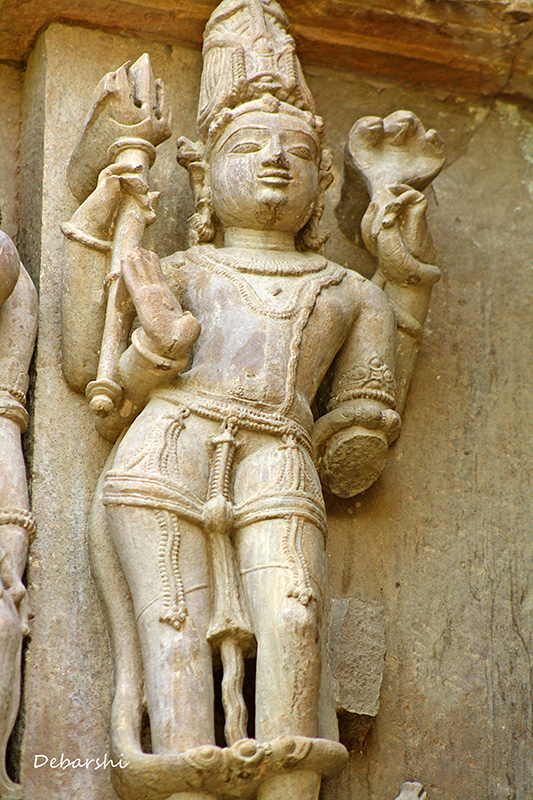
VARAHA MANDAPA
An open rotunda with a high pyramidal roof with the sacred Kalash (pot) elevated with 14 short pillars, The Varaha Mandapa is an exceptional piece of art estimated to be built between 900 to 925 AD.
You climb the stairs and just sit on the parapet admiring the enormous monolithic image of the Varaha. A single block of sandstone was used for this idol. It measures 2.6 metres long and 1.7 metres high. The sculpture is so smooth that it looks like metal.
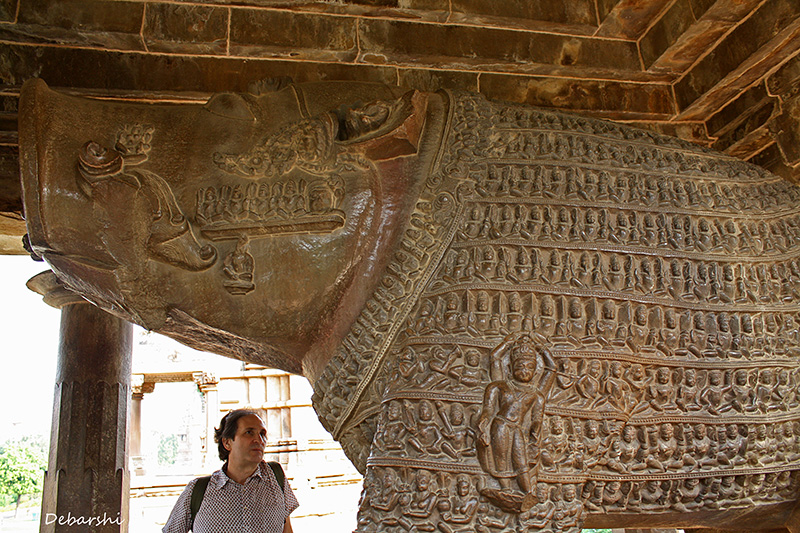
JAIN GROUP OF TEMPLES
The Jain trading community flourished during the Chandela rule and built about 31 temples east and south east of Khajuraho. Some have survived in in various states of preservation. There are three main Digambar Jain Temples you can visit to as part of the Khajuraho temple sculptures. On the way, you will also see the ruins of the Ghantal Temple with only a few pilasters and stone bells hanging from chains built around 960 AD.
PARSHVANATH TEMPLE
Parshvanath is the largest Jain Temples. It is also the best preserved. This temple deifies the Jain Tirthankara, Parshvanath . Adinath was the original deity of the temple. Lord Parshvanath was installed in 1860. Although this is a Jain Temple, the outer walls have the sculptures of Hindu (Vaishnav) gods.
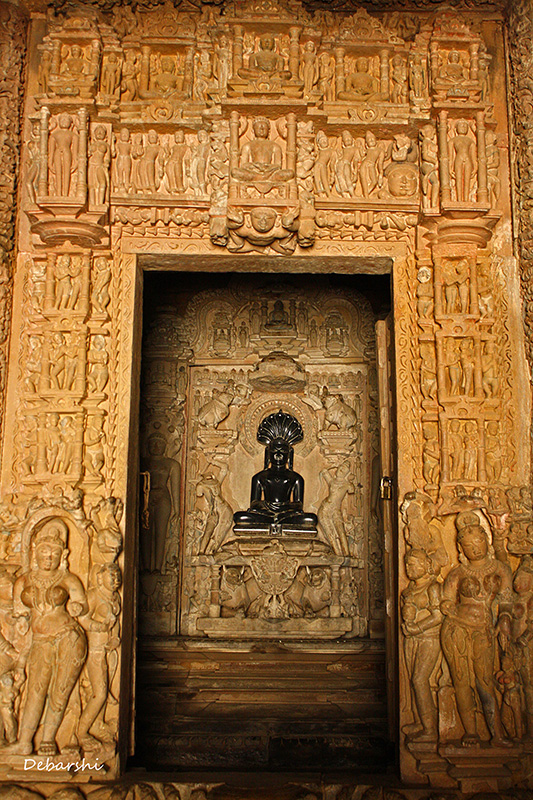
You can see some of the best examples of Khajuraho temple sculptures. Some of the notable ones are Vishnu-Lakshmi, Rama-Sita, Balarama-Revati, Parashurama, Hanuman and Brahma along with some of the finest carvings of the Surasundaris and the rare sculptures of 16 Digambar Jain Vidyadevis.
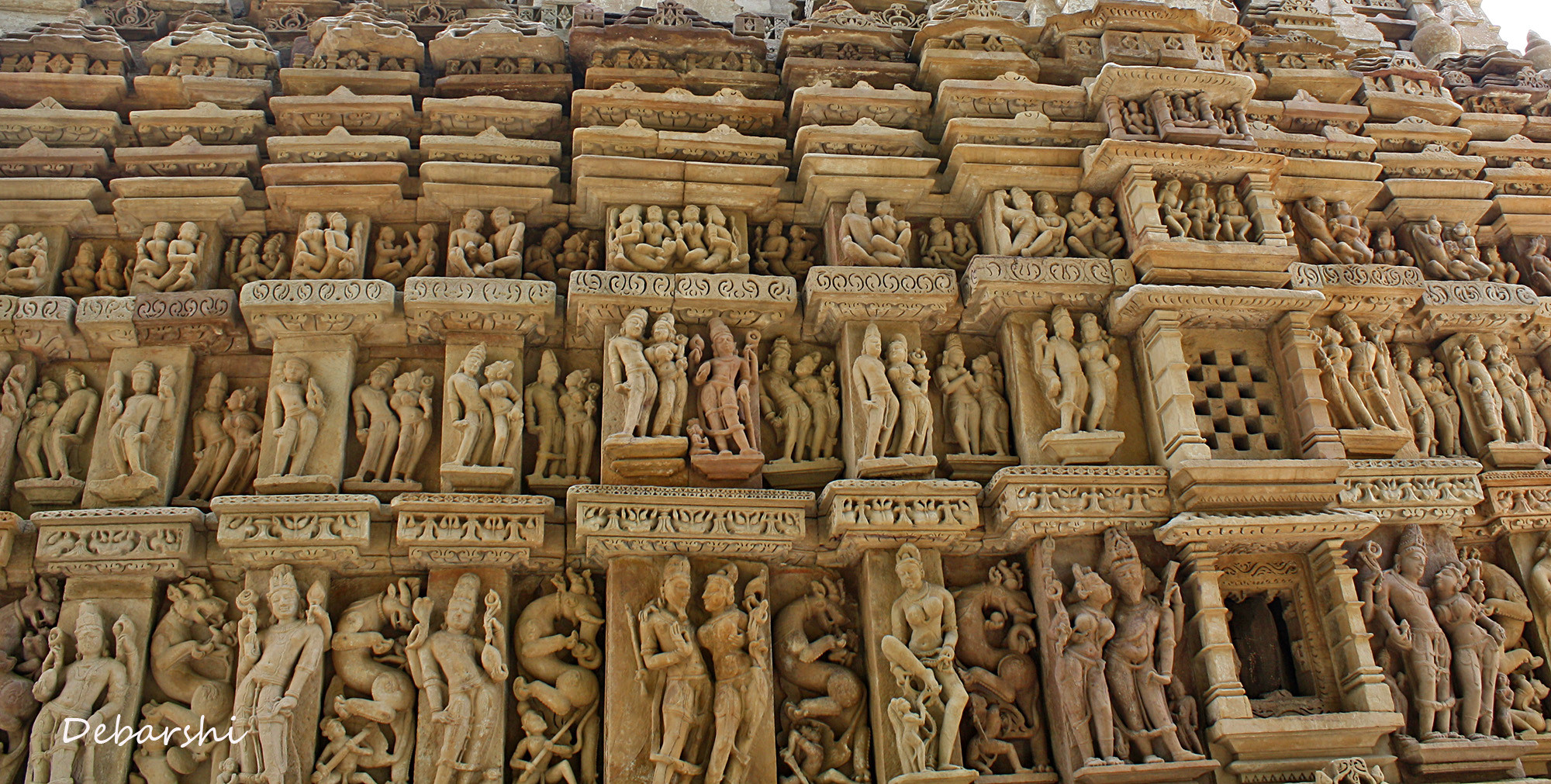
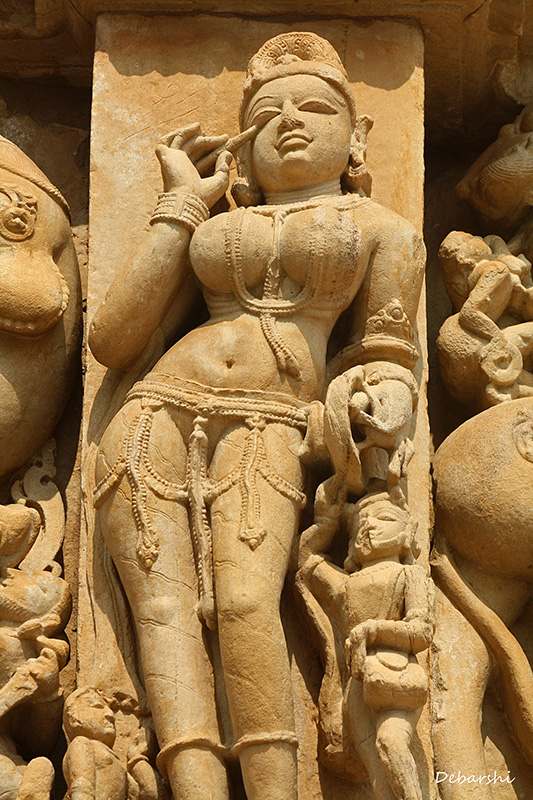
Our guide showed us an inscription on the temple wall. It states in 954 AD, Pahila donated his gardens and instructed his descendants to preserve the temple.
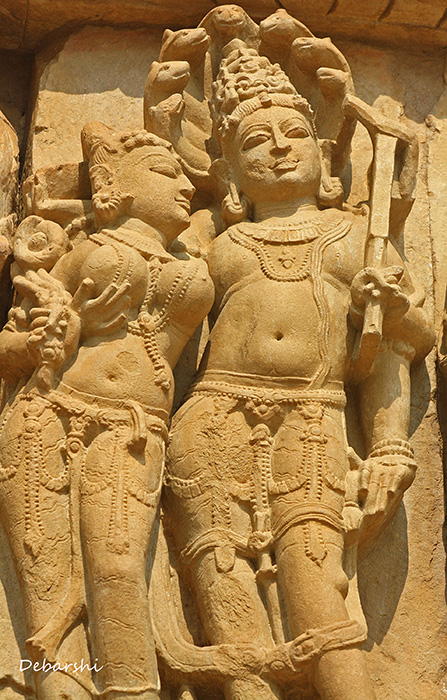
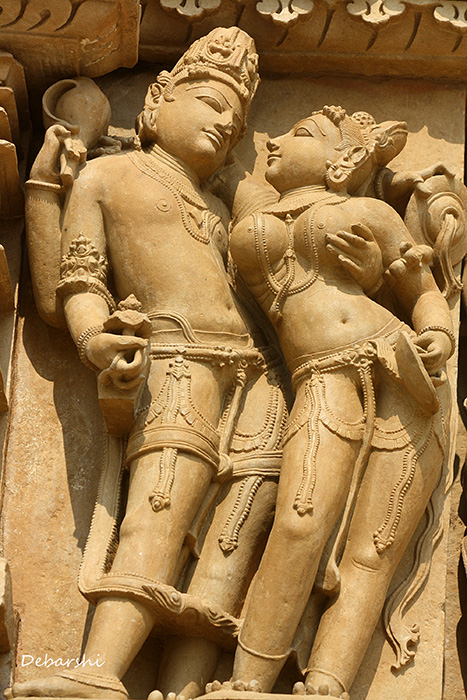
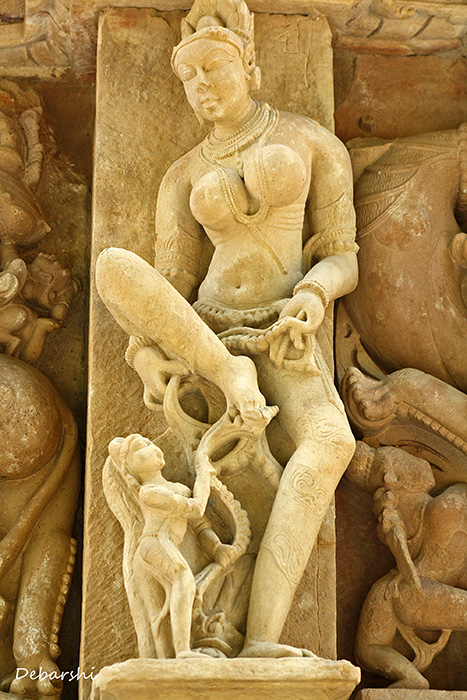
Do also ask your guide to show you the renowned magic square also known as Chautisa (34) Yantra, as each sub-square adds up to 34.
ADINATH TEMPLE
Built in late eleventh century AD, the smaller Adinath temple is beside the Parshvanath temple. Elegant and delicate Hindu sculptures adorn this temple , though it is a Jain temple. Today, only the vestibule and the sanctum survive. The Khajuraho temple sculptures here show Surasundaris, Vidyadharis, Vyalas, along with sculptures of the Yakshinis: Ambika and Chakreshvari.
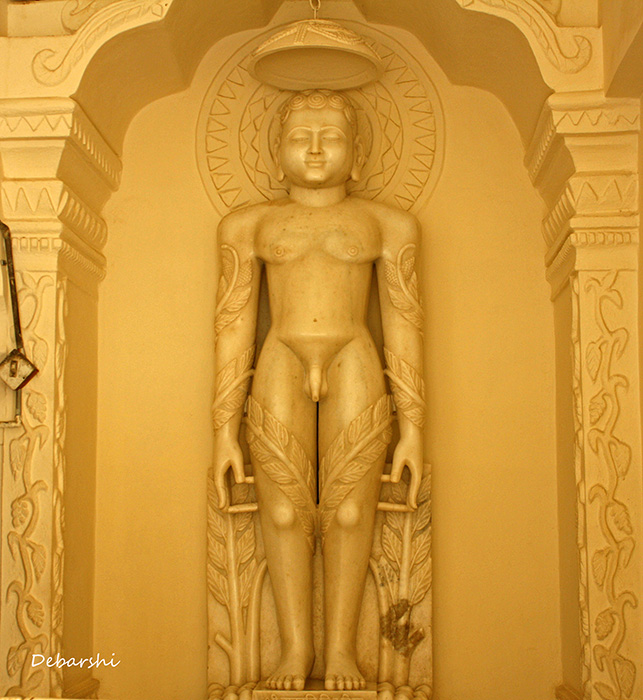
The most remarkable idol inscription is of Adinath (the Jain Tirthankar) . Furthermore , you can see the Dharmachakra with a bull, a portly Yaksha with a bag of money on his right and the Yakshini Chakreshvari sitting on Garuda on his left.
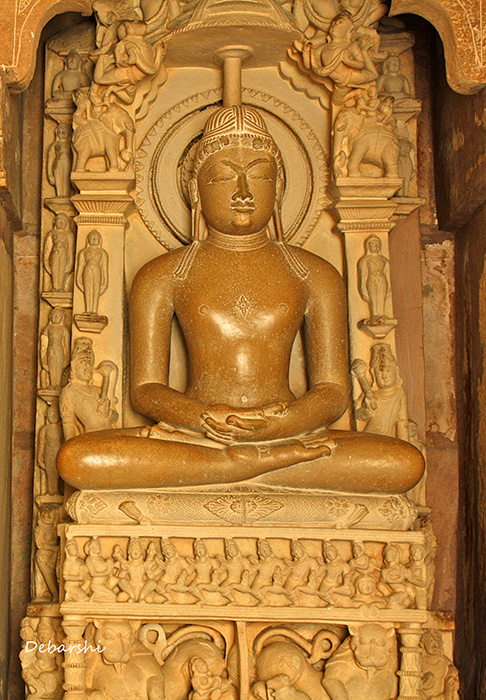
SHANTINATH TEMPLE
Shantinath temple is a functioning Digambar Jain temple with extensive renovations dedicated to the 16th Jain Tirthankar.
There are a number of shrines showing ancient Khajuraho temple sculptures. The main shrine has a massive statue of Lord Shantinath almost about 12 feet high. Among the other statues is a 4.5 m high Adinath statue from the 11th century. Our guide told us that about a now hidden inscription dated 1027-28 AD in the base of an Adinath image.
Do observe the statue of Kshetrapala and Yaksha (treasury guard) near the entrance.
There are also amazing images of other Tirthankaras – RishabhDev, Parshwanath, ChandraPrabhu. The divine symbols are Halo or Throne or Umbrella in the statues.
There is temple image gallery with photos of well-known Jain monuments of India.
SOUTH EASTERN GROUP OF TEMPLES
DULADEO TEMPLE
This temple was probably built in 1000–1150 AD, thus the last ones. This gained prominence as the Bridegroom’s temple (Dulha means bridegroom) , as a result known as the Kunwar Math.
The elements of nature had badly ravaged the temple . The spire, side walls and columns in the main hall had collapsed, but now renovated. Consequently , the temple is without any carvings.
The western wall has 3 sculptures bands with Mithuna Shilpa, celestial nymphs holding garlands with Shiva as the groom.
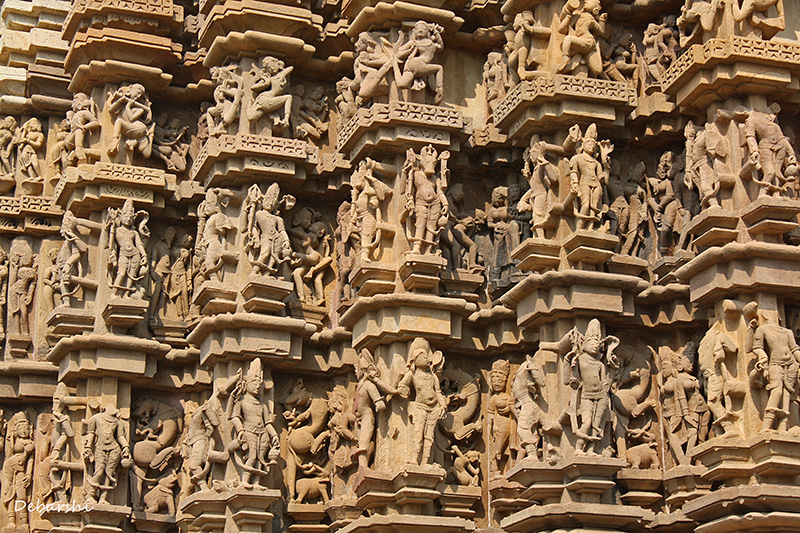
The octagonal MahaMandapa is most noteworthy. There are 20 extravagantly decked Apsaras in brackets, flying Vidyadharis and river goddesses.The deity of this temple is Shiva in the form of the Linga. There are also idols of Mahakal, Ganesha and Virbhadra.
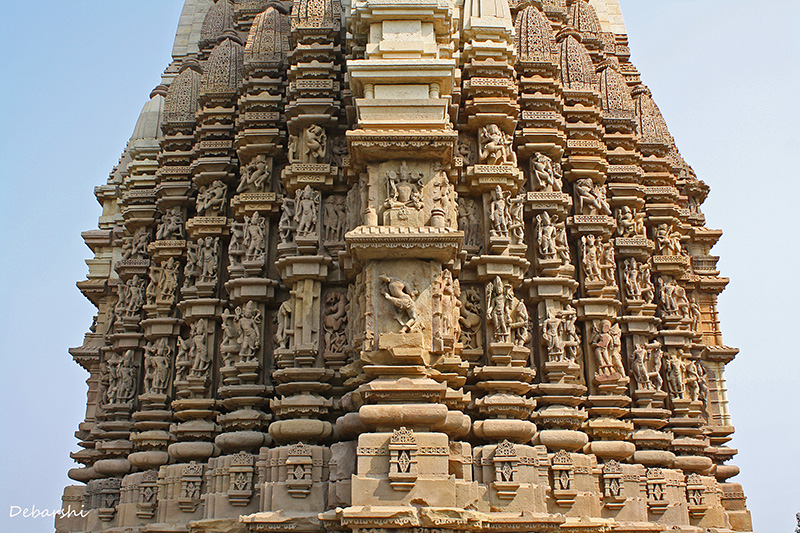
Our guide showed us the name Vasala inscribed in many places, inferred as the name of the chief artisan.
CHATURBHUJ TEMPLE
A unique feature of the Chaturbhuj temple is the direction – West. This is quite far away from the other temple groups and close to the Airport. This temple is dedicated to the 4 armed Lord Vishnu, hence the name Chaturbhuj.
On a square plinth, the temple is carved elaborately with 3 panels of carvings. Mithuna Shilpa is completely absent in this temple. The entrance has exquisite figures of the Holy Trinity – Brahma, Vishnu & Shiva. Most of all , do not miss the wonderful sculptures of river goddesses – Ganga on the right with the Crocodile and Yamuna on the left with the Turtle.
As you enter the temple, you will see the superb monolithic Vishnu idol. The idol is about 2.75 meters high and faces south. At dusk, the rays of the setting sun illuminate this idol such that it seems to be alive and breathing.
EASTERN GROUP OF TEMPLES
This group of temples are on the banks of the Khajur Lake (also known as the Ninora-tal). They are situated about a kilometre east from the Western Complex.
BRAHMA TEMPLE
This is a simple temple devoid of all the rich embellishments of the Western Group , built in 900 AD.
The square plan temple is in a field . The sanctum and pyramidal roof are the main unique features. The lattice windowsare an unique feature for illumination in the shrine. The portico is completely damaged. Twelve plain columns of granite support the GarbaGriha . The entrance is rather unadorned except for the Holy Trinity on the lintel and images of Ganga and Yamuna on the base.
Mistaken for a Brahma temple, you will soon see a 4 faced lingam in the GarbaGriha and historians now believe this to be Vishnu temple on account of the sculptures in the lintel. There are 5 manifestations of Lord Shiva in this temple.
JAVARI TEMPLE
This is a small striking nirandhara temple and dedicated to Vishnu.
There is no deity in the Hindu Pantheon by the name – Javari. Our guide mentioned the common belief – Javari donated the temple land and built the temple in 975 to 1100 AD.
Today, ASI has extensively renovated the temple . An entrance (Torana), hall (Mandapa) and sanctum (GarbaGriha) form this temple. Measuring about 11.88 meters in length and 6.4 meters in breadth, there are two friezes of sculptures portraying men and women in various stances.
The incredible entrance arch or Makara Torana made of stone has 4 ornate loops crowned by Kirtimukha and then you glance at the graceful spire (shikhar).
Sadly, the main idol of the 4 armed Vishnu is without a head.
VAMANA TEMPLE
Vamana , the dwarf incarnation of Vishnu is the main deity of this temple. The temple was probably built between 1050 to 1075 AD. It is about 19 meters tall and 14 meters wide.
This temple has the 7 projection sanctum but the entrance-porch is damaged. This is in the nirandhara style also.
There are some sensuous Mithuna Shilpa on the external walls of the temple of celestial beings apart along with damsels, musicians & dancers in the royal court.
KHAJURAHO TEMPLE SCULPTURES EXPLANATION
Various ancient Indian temples exhibit Mithuna Shilpa as a common art form.
For example :
- Konark Sun Temple in Orissa
- Virupaksha Temple in Hampi in Karnataka
- Markandeshwar Temple in Maharashtra
- Hoysaleswara temple in Halebidu in Karnataka
- Ranakpur Temples in Rajasthan to name a few.
There are several schools of thought among art historians and history professors on the presence of erotic art . Most noteworthy are the following explanations:
Schools of Thought
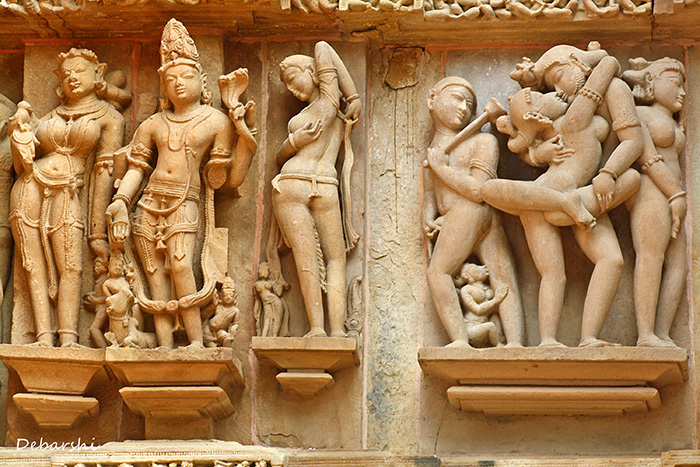
- The art represents a broad minded Hindu society with a vivid portrayal of daily lives. Therefore , Love and lust are an intrinsic part of life . The sculptures are also a celebration of womanhood with striking damsels adorning the temple walls.
- The sculptures are a portrayal of the Kaula – Kapalika sects. The tenets of Hindu philosophy of Dharma, Artha, Kama, Moksha mentions the final path to Nirvana (salvation) through resisting the sensual temptations .Hence, you will only see Mithuna Shilpa in the outer walls denoting lust and common desires are to be left behind before entering the temple.
- The encyclopedic Brihat-Samhita written by the ancient Indian astromer and mathematician Varahamihira does mention about the Mithuna Shilpa and Alankara (ornamental motifs) . Maybe, they serve the dual purpose of protecting the sacred temple and are auspicious to fertility and propagation of life.
- The Chandela rulers followed the Tantric Cult of yogic-philosophic concepts. Thus, Mithuna Shilpa serves a higher purpose of union with the Almighty. Sandhya Bhasha is the metaphorical language expressed in the sculptures. These metaphors or symbols edify the various canons of the cult
- For example: The couples engaged in love making represent the universal life forces through a union of Shiva and Shakti , the cosmic union of male and female.
- There is also a widely prevalent idea that the temples sought to be a medium for sex education. In the ancient & medieval era, life was divided into 4 age-based life stages –Brahmacharya (Celibacy and Education), Grihastha (Householder), Vanaprastha (Retirement) and Sanyasa (Renouncement). Young boys lived in the hermitage till maturity and adulthood. Hence ,the Mithuna Shilpa served to teach them about the worldly desires.
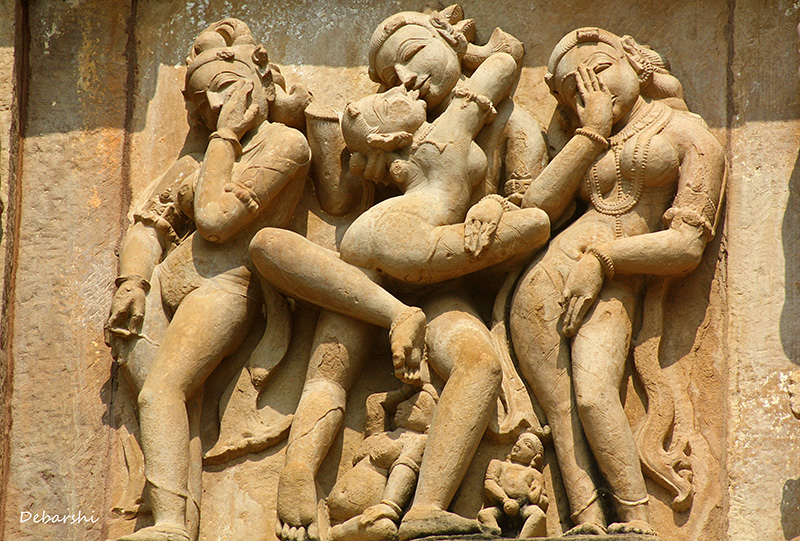
Best time to visit Khajuraho
The temples are open all year round from 7 am to 6 pm. The best time to visit is during the cooler months of November to March.
The Son-et-Lumiere (Sound & light Show) runs daily Hindi & English from 7 pm in the Western temple Complex. It is really worth seeing this depiction of the Chandela dynasty and the history of the temples. The baritone voice of the Bollywood Superstar, Amitabh Bachchan narrates this show.
February is a great time to visit Khajuraho. February hosts the annual Khajuraho Dance festival. Renowned danseuses perform various forms of Indian classical dance styles like Kathak, Bharatanatyam, Odissi, Kuchipudi, Manipuri and Kathakali. The artists perform in in an open-air auditorium in front of the illuminated Chitragupta Temple and the Vishvanath Temple .
Where to Stay?
Khajuraho has numerous places to stay suiting every pocket.
Premium
There are many luxury properties notable among them are The Lalit Temple View,Ramada, Radisson Hotel, Syna Heritage Hotel, Clarks Khajuraho.
We stayed at the Radisson Khajuraho in a Pool view room. Dinners & breakfasts are large buffet spreads overlooking the swimming pool. The lobby plays Indian Instrumental music in the dining area consequently enhancing the experience.
MP Tourism Properties
MP Tourism operates Hotel Payal , Hotel Jhankar and the Tourist Village in Khajuraho. Rustic cottages ,clean rooms and good service are highlights of the Tourist Village.
How to reach Khajuraho?
Air
Direct Flights are available from Delhi, Mumbai, Hyderabad, Varanasi and Indore. Air India & Jet Airways operates daily flights. Khajuraho has a small , modern aerodrome equipped with advanced features. It is about 2 km from the city centre and general taxi services are available from the airport.
Rail
Indian Railways also connect Khajuraho Station with Delhi, Jhansi, Mahoba and Harpalpur. The station is 5 km from the city centre .Taxi or auto rickshaw services are easily available from the airport.
Satna is a major railway station (about 115 km) and connects Mumbai, Kolkata, Kanpur, Udaipur and Varanasi. The Mumbai Mail runs daily connections.
Road
National & State Highway connect Khajuraho with nearby cities. Satna is about 115 km on the NH 39. Jabalpur is on NH 34 and Bhopal is on NH146. There are regular bus services from Satna & Jhansi as well.
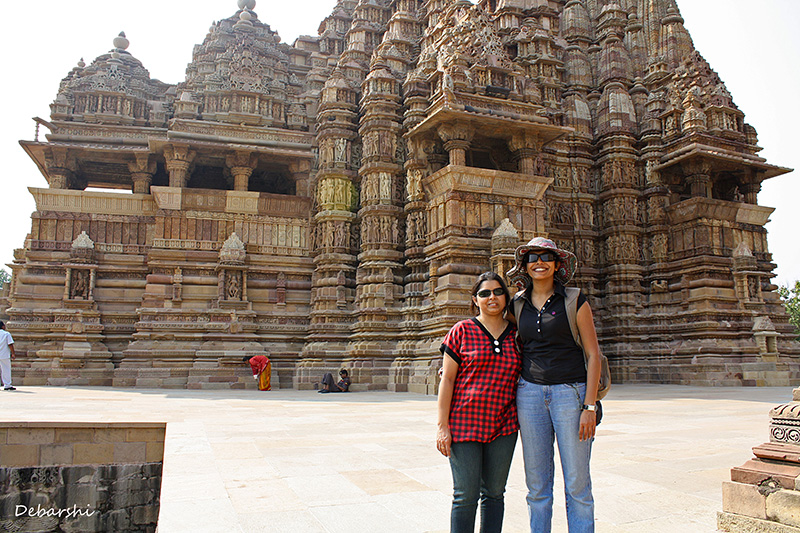
One of the Tourist places near Khajuraho is the Panna Tiger Reserve about 44 km away. You can do a day trip and read more about Panna in my post.
